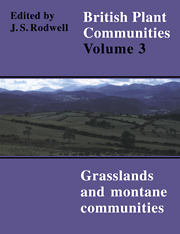Book contents
- Frontmatter
- Contents
- List of Figures
- Preface and Acknowledgements
- Preamble
- Mesotrophic Grasslands
- Community Descriptions
- Calcicolous Grasslands
- Community Descriptions
- Calcifugous Grasslands and Montane Communities
- Community Descriptions
- Index of Synonyms to Grasslands and Montane Communities
- Index of Species in Grasslands and Montane Communities
- Bibliography
U5 - Nar Dus Stricta-Galium Saxatile Grassland
Published online by Cambridge University Press: 04 July 2020
- Frontmatter
- Contents
- List of Figures
- Preface and Acknowledgements
- Preamble
- Mesotrophic Grasslands
- Community Descriptions
- Calcicolous Grasslands
- Community Descriptions
- Calcifugous Grasslands and Montane Communities
- Community Descriptions
- Index of Synonyms to Grasslands and Montane Communities
- Index of Species in Grasslands and Montane Communities
- Bibliography
Summary
Synonymy
Nardetum strictae Smith & Moss 1903, Smith & Rankin 1903, Lewis 1904a,b, Moss 1911, Tansley 1939; Grass moor Smith 1911 p.p; Nardus-Deschampsia grassland Adamson 1918; Marginal Nardetum Smith 1918; Nardetum Price Evans 1932; Festuca-Nardus-Juncus squarrosus Grassland Ratcliffe 1959a; Nardetum sub-alpinum McVean & Ratcliffe 1962, Meek 1976, Ferreira 1978; Nardus-Trichophorum nodum McVean & Ratcliffe 1962p.p; Type A Nardus stricta!Festuca ovina!Deschampsia flexuosa grassland King 1962; Nardus-Festuca-Deschampsia Type 2 grassland King & Nicholson 1964; Species-rich Juncus-Nardus nodum Welch 1967; Species-poor Nardetum sub-alpinum Eddy et al. 1969; Nardus stricta sociation Edgell 1969; Nardo-Juncetum squarrosi Birks 1973, Evans et al. 1977, Hill & Evans 1978, p.p.; Juncosquarrosi-Festucetum tenuifoliae Birse & Robertson 1976, Birse 1980 p.p.; Nardus stricta-Anthoxanthum odoratum nodum Huntley 1979; Cirsium palustre-Nar dus stricta Community Birse 1980.
Constant species
Agrostis capillaris, Festuca ovinalvivipara, Galium saxatile, Nardus stricta, Potentilla erecta, Rhytidiadelphus squarrosus.
Physiognomy
The Nardus stricta-Galium saxatile grassland includes most of the grassier vegetation in which Nardus stricta plays a prominent role. Nardus is usually the most abundant plant in these swards, often dominant, sometimes overwhelmingly so, its structural importance helping to separate the community from similar grasslands in which it is a frequent companion, but at lower cover. In typical stands, the distinctive habit of this grass gives the vegetation a quite unmistakable stamp and exerts a controlling influence on the variety and distribution of the associates. The physiognomy is a densely tufted one, with the shoots tightly packed and congested below with the persistent remains of the tough, basal sheaths, new growth being crowded in among the old to build up tussocks of sometimes substantial size. These develop on shortly-branching, superficial rhizomes which grow fairly slowly and eventually die from behind, expanding the colony marginally as a thick sod of closely-spaced tussocks accumulating humose detritus between them. Vigorous growth of this kind can oust most other potential dominants, although the developing peaty topsoil can provide a congenial substrate for a range of smaller herbs and bryophytes. Characteristically, the Nardus itself maintains contact with the underlying mineral substrate by means of thick roots (Smith 1918, Chadwick 1960, Pearsall 1968).
- Type
- Chapter
- Information
- British Plant Communities , pp. 352 - 367Publisher: Cambridge University PressPrint publication year: 1992

